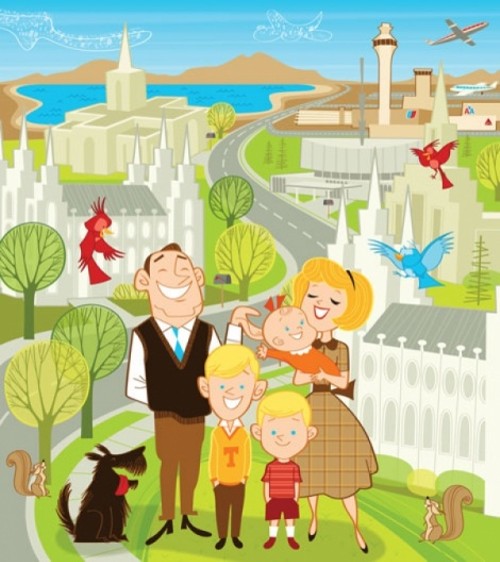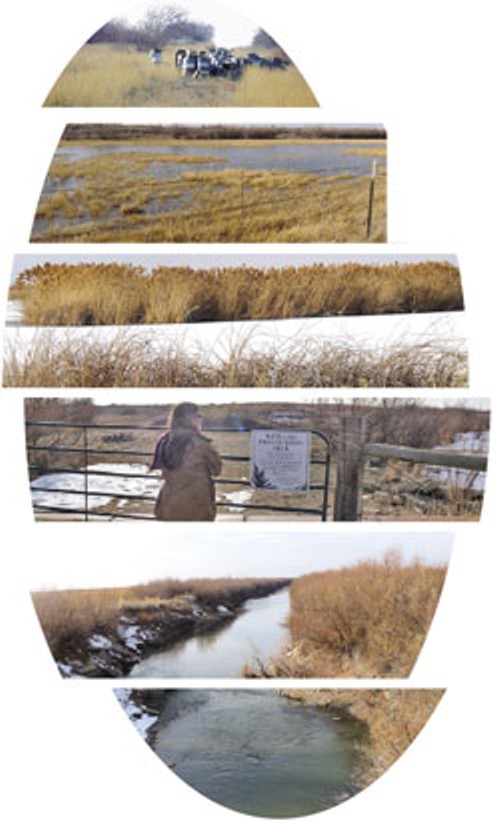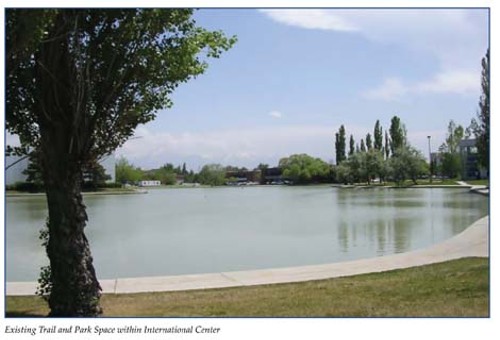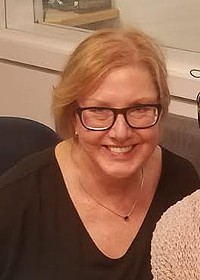LDS Church & SLC Development
This Is the Place: The LDS Church eyes barren wetlands as a future city within Salt Lake City.
By Katharine Biele @kathybieleHere, eight miles from the urban capital, lie 19,000 acres of brush, streams and nearly forgotten landfills.
“Nearly” is the operative word. Plans are afoot to get a long-awaited master plan in gear for a proposed settlement that would permanently change the face of this urban capital.
Most assuredly, it would change the politics, too.
What is now home mostly to birds, mosquitoes and deer flies would eventually house up to 70,000 people in “a variety of neighborhoods with a range of housing types for a diverse population … minutes from downtown and the airport,” according to a recent update of the 2009 draft of the Northwest Quadrant Master Plan.
Located between Bangerter Highway and 8800 West, from 2100 South to 3700 North, the quadrant is the last major expanse of undeveloped land in the city. What is envisioned is nothing less than another city appended to the core. With 70,000 potential residents (the city’s principal planner, Everett Joyce, sees upwards of 300,000 in the future), the development would rival many cities in Utah.
This is Salt Lake City’s answer to Daybreak, the South Jordan megaburb that Kennecott Land Company built on recovered mining property, except the Northwest Quadrant sits on a floodplain dotted by aging landfills susceptible to earthquake liquefaction.
“I like to think it’s better than Daybreak,” says Salt Lake City Councilman Carlton Christensen. “This is an opportunity to develop a community that really espouses some of the core values we espouse in this city, and if it can’t, shame on us.”
The values Christensen talks about are things like sustainability, air quality and walkability. There are also values—albeit unspoken—of Utah’s conservative LDS majority that come into play.
Political Hay
“People
don’t like to talk about it much,” says former Salt Lake City Mayor
Rocky Anderson, never one to shy away from controversy. “This could
alter the political makeup of this community, and we could end up being
another Sandy.”
The master plan doesn’t exactly mention social engineering as a goal, and the area’s largest landowner—The Church of Jesus Christ of Latter-day Saints—is deferring to the city as to what those goals are. Questions about liquor licensing, free-speech areas and even dog ownership were answered simply: “We are a longtime property owner in the area—our ownership originally goes back years as a welfare farm. However, what our role in any possible development in the area might be is undetermined until Salt Lake City has determined its master plan for the area.”
As the LDS Church is the largest landowner, it seems only natural to inquire about the development through its property arms—Suburban Land Reserve and Property Reserve Inc. But questions sent to Carl Duke, property manager for SLR, were eventually fielded by the LDS Church’s communications department.
Stephen Goldsmith, former planning director for the city, was surprised at the easy interface between the entities. “I’m looking at the ethical construct of this,” he puzzles. “As the church began to reorganize their for-profit side, they moved [real-estate development] into different hands, and they have worked very hard to differentiate their ecclesiastical side from their commercial side.”
But the Northwest Quadrant holds such huge implications for both the city and the church that the church can’t simply pass it off as a garden-variety development project.
The church has often mentioned its history of stimulus aid amid poor economic times. According to a history by Garth Magnum, in the Depression ’30s, the LDS Church began its welfare system by placing unemployed urban Mormons with self-sufficient farmers. Perhaps there’s some irony in the fact that the church’s welfare goal for the Northwest Quadrant leaves farms behind in favor of an urban village.
The Green Edge
Whether
this plan stimulates positively or negatively is a question that
planners have yet to fully evaluate. Promises of bright development and
exciting opportunities are often just that. The Gateway was slated to
complement downtown Salt Lake City instead of draining the core of its
retail and business tenants.
The LDS Church, of course, has since stepped in to fill what The Gateway sucked away. It’s developing the massive City Creek Center where two downtown malls once thrived.
Salt Lake City Councilman S%uFFFDren Simonsen is concerned that the Northwest Quadrant development will suck even more from the city and its environs and could well sidetrack the already stalled plans to develop around transit stops. He’s been talking about the master plan for the past four years, but his strident advocacy of planning and sustainability haven’t earned him a lot of brownie points from his colleagues.
“I’m a bit dismayed with the process because I don’t think we’ve gone through an analysis of not building,” he says. “When you start with the assumption that you do only one thing—to develop it—then everything you put together in your toolbox supports your assumption.”
Manure in the Mix
Indeed, the plan is all about development. It “represents an important milestone in the continuing development of Salt Lake City,” the plan says.
“The purpose of this plan is to apply the community’s shared values and goals to the establishment of a basis for rational decision-making and planning-policy formulation by Salt Lake City’s decisionmakers regarding future development of the Northwest Quadrant area.”
“This is not just a plan for a subdivision; it’s a plan for a whole new town,” says Jennifer Gillmor Larson, whose family has ranched the area for 100 years. A 2007 visioning workshop came up with an, ahem, “sustainable” scenario to “balance and integrate the environmental, social and economic components of the community; meet the needs of existing and future generations; respect the needs of other communities in the region and globally; and preserve and enhance natural ecological functions.”
Contrast that picture-perfect vision with what’s actually there today: a winding dirt road from the airport’s International Center (left) dotted with warning signs against stopping, likely a safety precaution for the airport to keep terrorists or kids playing with laser beams at bay.
This will be a self-contained, idyllic village where residents could walk to a farmers market. Buildings will be “green,” constructed for the best possible energy use, and bridges and underpasses will cross natural habitat areas to “ensure continuous greenway connections.” Besides a town center, there will be a village center and neighborhood centers—all mixed-use gathering places for the diverse, eco-friendly population.
“A significant portion of the Northwest Quadrant will form a hierarchy of natural systems; create a green edge to Salt Lake City; buffer the Great Salt Lake and Bailey’s Lake; and create an internal greenway system within the developed portion of the Northwest Quadrant,” the plan says.
The emphasis on green is somewhat ironic given the lack of it in this area.
More by Katharine Biele
-
Deseret News poll shows Donald Trump skating to another victory in Utah.
Hits & Misses
- Apr 17, 2024
-
LDS General Conference dominates local news while stories on diversity and discrimination take a back seat
Hits & Misses
- Apr 10, 2024
-
Utah's GOP Senate candidates try to out-MAGA each other in a race to the bottom.
Hits & Misses
- Apr 3, 2024
- More »
Latest in Cover Story
Readers also liked…
-
Forget the family pedigree—Robert F. Kennedy Jr should not be the next president of the United States
Trojan Horse
- Jun 21, 2023
-
Women decry harassment and toxic culture at St. George auto dealership
Men at Work
- Oct 11, 2023








